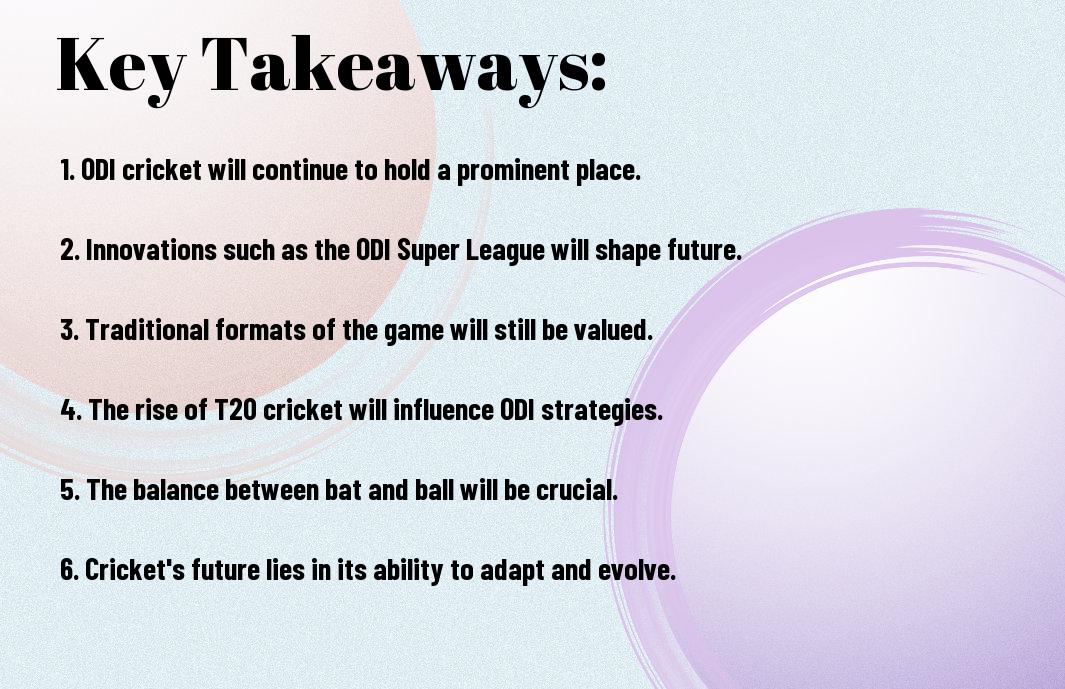Cricket's Place in Future of ODIs – Review and Predictions

The Current State of ODIs
If you’re a cricket fan, you are well aware of the significance of One Day Internationals (ODIs) in the cricketing world. As of late, ODIs have seen a mix of highs and lows in terms of viewership, popularity, and overall reception from fans and experts alike. Let’s delve into the current state of ODIs and analyze the various aspects that shape their place in the world of cricket.
Popularity and Viewership Trends
When it comes to the popularity and viewership of ODIs in recent years, there has been a noticeable shift. While ODIs still attract a dedicated fan base, the rise of T20 cricket has impacted their overall viewership. The fast-paced and high-octane nature of T20 matches has drawn in a new generation of cricket fans, leading to a decline in ODI viewership in some regions. However, in several cricket-crazy nations, ODIs continue to be a staple, drawing in thousands of spectators to stadiums and millions more in front of their television screens. The upcoming schedule and match-ups can have a huge impact on the overall popularity and viewership trends of ODIs.
Comparing Formats – T20s and Test Matches
When comparing ODIs to T20s and test matches, each format brings a unique flavor to the game. In T20s, the emphasis is on quick runs and big hits, making it a thrilling spectacle for fans. On the other hand, test matches are a true test of skill, endurance, and strategy, often lasting for five days and showcasing the grueling nature of the sport. ODIs, sitting between the two extremes, strike a balance between excitement and strategy, making them an enticing prospect for both players and fans. Below is a comparison of the key aspects of each format:
Comparison of Cricket Formats| Aspects | ODIs |
| Pace of the Game | Fast-paced with a mix of aggression and strategy |
| Duration | One day, with each team getting 50 overs to play |
| Viewer Engagement | Keeps the audience engaged with a balanced mix of excitement and strategy |
| Flexibility | Allows for momentum shifts and strategic play |

Innovations and Changes in ODIs
The future of ODIs is being shaped by various innovations and changes in the way the game is played and experienced. These advancements are redefining the landscape of cricket and are set to have a significant impact on the future of ODIs.
The Impact of Technology on Gameplay
The advancements in technology have revolutionized the way ODIs are played and experienced. The introduction of technologies such as UltraEdge, Snickometer, and Hawk-Eye has transformed the game by providing more accurate decisions and enhancing the viewing experience for the fans. The use of technology has also led to the implementation of the Decision Review System (DRS), which has played a crucial role in reducing umpiring errors and ensuring fair outcomes. Additionally, the use of player performance analysis tools has allowed teams to strategize and make informed decisions based on detailed statistical data, thereby improving the overall quality of the game.
Rule Changes and their Implications
The governing bodies of cricket have been proactive in introducing rule changes to enhance the excitement and competitiveness of ODIs. Innovations such as the introduction of the powerplay, the use of colored clothing and white cricket balls, and the implementation of fielding restrictions during specific overs have added a new dimension to the game. These changes have not only made the game more appealing to the audience but have also challenged players to adapt and innovate in their approach to the game, making ODIs more dynamic and engaging.
Predicting the Future
Now, let’s take a look at the potential future of ODIs and what changes in the cricketing landscape we can expect to see. With the sport constantly evolving, it’s essential to stay ahead of the curve and anticipate the upcoming developments in the world of cricket.
Potential Shifts in Audience Preferences
As the next generation of cricket fans emerges, their viewing habits and preferences may significantly impact the future of ODIs. With the rise of digital platforms and streaming services, traditional TV viewership could decline, leading to a shift in how ODIs are consumed. It’s crucial for the cricketing industry to adapt to these changing preferences and explore innovative ways to engage with fans across various platforms. The challenge lies in finding the right balance between traditional formats and modern technologies to keep the sport relevant and appealing to a wider audience.
The Rise of New Cricketing Nations
With the increasing global popularity of cricket, new nations are emerging as strong contenders in the international cricketing arena. Countries such as Afghanistan, Ireland, and Nepal have shown significant progress and potential, posing a challenge to the traditional cricketing powerhouses. This expansion of cricketing talent not only adds diversity to the sport but also creates exciting opportunities for international competitions. As these new nations continue to develop and invest in their cricketing infrastructure, they are reshaping the future landscape of ODIs and bringing fresh talent to the forefront of the game.

How Will the Debate on the Cricket World Cup Format Impact the Future of ODIs?
The ongoing debate over the ideal cricket world cup format has sparked discussions about the future of ODIs. As stakeholders weigh in on the pros and cons, the decision made could have lasting implications for the way one-day international cricket is played and enjoyed by fans worldwide.
Future Challenges and Opportunities
After reviewing the current state of ODIs, it’s important to consider the challenges and opportunities that lie ahead for the format. As the cricket landscape continues to evolve, there are several key areas that will need to be addressed in order to ensure the continued success and growth of ODIs.
Sustaining Interest in the ODI Format
One of the most pressing challenges facing ODIs is the need to sustain interest in the format. With the rise of T20 cricket and the increasing popularity of leagues such as the Indian Premier League, there is a risk that ODIs could be overshadowed. In order to address this, it will be important to find ways to make the format more engaging and exciting for fans. This could involve exploring new competition structures, introducing new rules to add excitement, or finding innovative ways to market and promote ODIs.
Marketing and Global Expansion Strategies
Another key area for consideration is the marketing and global expansion of ODIs. While the format has a strong following in traditional cricket-playing nations, there is potential for growth in non-traditional markets. Developing effective marketing strategies and expanding the reach of ODIs to new audiences will be crucial for ensuring the long-term success of the format. This may involve promoting ODIs in new regions, partnering with local cricket associations, or leveraging digital platforms to reach a global audience.
Cricket’s Place in Future of ODIs – Review and Predictions
Summing up, the future of ODIs in cricket looks promising and dynamic. With the evolution of the game and the introduction of new technologies, the experience of watching and playing ODIs is expected to be more immersive and engaging. As a cricket fan, you can look forward to witnessing more innovative strategies, dramatic performances, and thrilling finishes in the upcoming ODIs. The format is likely to continue captivating audiences and attracting new fans from around the world. So, be prepared to be a part of the exciting journey of ODIs as it continues to shape the future of cricket.
FAQ
Q: What is the current standing of ODIs in the world of cricket?
A: Currently, ODIs (One Day Internationals) hold a significant place in the world of cricket. They are a popular format of the game, especially in countries like India, Australia, England, and Pakistan. ODIs continue to draw large crowds and strong viewership, making them a key element in the future of cricket.
Q: What trends and changes are anticipated for ODIs in the future?
A: In the future, ODIs are expected to undergo several changes and innovations. With the introduction of new rules and regulations, as well as advancements in technology, the game is likely to become more fast-paced and engaging. Additionally, there may be an increase in the number of ODI matches played, leading to a more extensive calendar and greater opportunities for teams and players.
Q: How do predictions for the future of ODIs impact the sport of cricket as a whole?
A: The predictions for the future of ODIs have a significant impact on cricket as a whole. As one of the three formats of international cricket, the evolution of ODIs affects the entire ecosystem of the sport. Anticipated changes in ODIs can influence player strategies, team dynamics, and fan experiences, ultimately shaping the direction and growth of cricket in the coming years.






